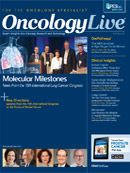Publication
Article
Oncology Live®
Noted Researcher Offers Overview of Emerging Therapies
Author(s):
Within the past two years, the oncology community has seen the FDA approve three practice-changing therapies for breast cancer and the progress of a promising fourth agent, T-DM1.
Joyce A. O’Shaughnessy, MD
Co-Director, Breast Cancer Research, Baylor Charles A. Sammons Cancer Center, Texas Oncology/US Oncology, Dallas, TX
Within the past two years, the oncology community has seen the FDA approve three practice-changing therapies for breast cancer—pertuzumab (Perjeta), everolimus (Afinitor), and eribulin mesylate (Halaven)— and the progress of a promising fourth agent, T-DM1.
Joyce A. O’Shaughnessy, MD, who served as program director for the 11th International Congress on the Future of Breast Cancer, discussed emerging therapies in an interview.
Question: How does the June approval of pertuzumab, which is indicated in combination with trastuzumab and docetaxel, change the treatment paradigm for metastatic HER2-positive disease? O’Shaughnessy: Pertuzumab is definitely game-changing. Patients with first-line metastatic HER2-positive breast cancer really need both antibodies— pertuzumab and trastuzumab—along with docetaxel. It’s just a much more powerful way to inhibit that pathway in its entirety. In my mind, it’s OK if they’ve had docetaxel/carboplatin/pertuzumab in the adjuvant setting, even within a year. If they’re resistant and the cancer comes back, let’s give them the pertuzumab and see if that overcomes the resistance; if it does, then the trastuzumab and docetaxel may really work.
Fortunately, pertuzumab looks to be very, very safe, and there’s no increased cardiac risk. In fact, it looked to be less. There is more diarrhea, so we have to tell the patients about that. They may need some Imodium, but we would expect the diarrhea to get better over time.
How does the July approval of everolimus in combination with exemestane change the treatment paradigm for postmenopausal women with relapsed estrogen receptor (ER)- positive metastatic breast cancer?
Everolimus is the first agent we have that’s directly targeted to the PI3 kinase pathway known to be so active in ER-positive breast cancers—particularly those that become resistant to anastrozole or letrozole. We want to give patients the benefit we saw in BOLERO-2 [N Engl J Med. 2012;366(6):520-529], which means bringing in exemestane and everolimus right after anastrozole or letrozole. If patients have ER-positive disease and are later- line because these agents weren’t available to them, I think it’s quite reasonable to give them an aromatase inhibitor (AI) and everolimus at any line of therapy. Going forward, as patients recur in the metastatic setting on adjuvant anastrozole/letrozole or get a first-line nonsteroidal AI and then progress, I think exemestane and everolimus are definitely the way to go.
Questions for the future include how best to sequence this combination for patients with different stages of disease, and the outcome of studies of everolimus in HER2-positive metastatic breast cancer.
Since the main toxicity with everolimus is mucositis, our practice is using prophylactic steroid mouth rinses and, when necessary, dose holding and reduction. There is a low incidence of pneumonitis, and we have to alert the patients to any coughing or dyspnea on exertion, get a chest x-ray or a CT scan if there are infiltrates, and temporarily stop the agent.
What are the implications for the use of eribulin mesylate, a novel cytotoxic therapy the FDA approved in November 2010 to treat patients with metastatic breast cancer who previously received chemotherapy including anthracyclines and taxanes?
Eribulin is a novel, quite non-cross-resistant molecule, and very active. It has a survivor advantage, of course, in the metastatic setting. I’m particularly impressed with it in luminal breast cancer and ER-positive disease. I’ve seen very good activity, as well, in triple-negative breast cancer, particularly metastatic to luminal sites such as bone or liver. And the agent is being evaluated in earlier-line metastatic breast cancer. For example, we now know it is safe to give eribulin with trastuzumab, and we’ll have a lot of data coming out at the San Antonio Breast Cancer Symposium.
Genentech is seeking the FDA’s approval of T-DM1 to treat patients with HER2-positive metastatic breast cancer, and plans to launch an expanded access program in the United States while its Biologics License Application is pending. What would an approval mean for the treatment of this condition?
T-DM1, which combines trastuzumab and emtansine with a stable linker, will be a very, very nice option in the metastatic setting. We hope to see it commercially available by the end of the year or early next year, because it has a survival advantage over capecitabine and lapatinib in patients who have already had trastuzumab. It’s very well-tolerated; a woman can continue to feel great, super. We’d like to use it in the first-line metastatic setting, but we’ll have to wait for the results of the phase III MARIANNE trial [J Clin Oncol. 29: 2011(suppl; abstr TPS102)] for data on T-DM1 alone or with pertuzumab to see how that will shake out.
What other promising agents are in the pipeline for the treatment of breast cancer?
In my talk on novel cytotoxic agents, I mentioned irinotecan approaches, both pegylated SM-38, the active moiety of irinotecan, and the new polymer-conjugated irinotecan to give it a nice long half-life called NKTR-102. These agents in phase II trials are substantially noncross-resistant with our standard anthracycline/taxane/ capecitabine approaches. And now NKTR-102 has entered a very large phase III trial compared to treatment of physician’s choice in patients with both ER-positive and triple-negative breast cancer [ClinicalTrials.gov identifier NCT01492101]. So irinotecan is an agent we’d want to know about in case we have patients with very refractory disease who are not responding. Even outside of a clinical trial, there’s certainly adequate information that would justify the use of irinotecan, particularly in our triple-negative patients who are refractory to other strategies.

































